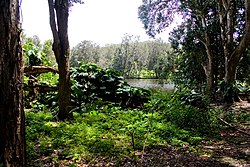| Currumbin Wildlife Sanctuary | |
|---|---|
 Currumbin Wildlife Sanctuary | |
| Location | 28 Tomewin Street, Currumbin, Queensland, Australia |
| Coordinates | 28°08′06″S 153°29′17″E / 28.135°S 153.488°E |
| Built | 1947 onwards |
| Official name | Currumbin Wildlife Sanctuary |
| Type | state heritage (landscape, built) |
| Designated | 18 September 2009 |
| Reference no. | 602720 |
| Significant period | 1947 onwards |
| Significant components | watercourse – creek, aviary, animal enclosure/s, pens/cages, trees – remnant scrub, zoological garden, miniature tram/train, other – recreation/entertainment: component |
| Currumbin Wildlife Sanctuary | |
|---|---|
 | |
| Date opened | 1947 |
| Location | Currumbin, Gold Coast, Queensland, Australia |
| Website | www |
Currumbin Wildlife Sanctuary is a heritage-listed zoological garden at 28 Tomewin Street, Currumbin, Queensland, Australia. It was built in 1947 onwards. It was added to the Queensland Heritage Register on 18 September 2009.[1] The sanctuary is world-renowned for its feeding of huge flocks of free-flying wild rainbow lorikeets, which come to the sanctuary to feast off the special mixture which the lorikeets eat.
The multitude of events, shows and attractions include dingo encounters, free flight bird shows and feeding of the park's massive saltwater crocodile. The park also contains a serious aspect of its work and exhibits, and behind the scenes includes a state-of-the-art veterinary and rehabilitation hospital.
The sanctuary was opened as the Currumbin Bird Sanctuary by Alex Griffiths in 1947 as a scheme to stop the local lorikeet population destroying his flower plantations. The lorikeets still flock to the sanctuary twice daily to be fed by visitors. The sanctuary now houses one of the largest collections of Australian native species in the world. Exhibits include Tasmanian devils, a reptile house and in December 2017 the sanctuary opened their new exotics precinct Lost Valley which is home to lemurs, red pandas, capybara, cotton-top tamarins, tree kangaroos and one of largest walk-through aviary in the Southern Hemisphere with free flying birds. The sanctuary also has a miniature railway that has been operating since 1964. In May 2011, the hospital has appealed for donations and government support as it faces a funding shortage that may force it to turn away injured wildlife.[2]
- ^ "Currumbin Wildlife Sanctuary (entry 602720)". Queensland Heritage Register. Queensland Heritage Council. Retrieved 1 August 2014.
- ^ Marschke, Tanya (19 May 2011). "Wildlife hospital in danger of closing". Gold Coast Sun. Archived from the original on 3 June 2011. Retrieved 26 May 2011.

